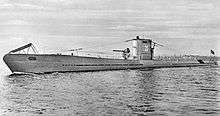German submarine U-26 (1936)
 | |
| History | |
|---|---|
| Name: | U-26 |
| Ordered: | 17 December 1934 |
| Builder: | DeSchiMAG AG Weser, Bremen |
| Yard number: | 904 |
| Laid down: | 1 August 1935 |
| Launched: | 14 March 1936 |
| Commissioned: | 6 May 1936 |
| Fate: | Scuttled 1 July 1940, southwest of Ireland. 48 survivors[1] |
| General characteristics [2] | |
| Displacement: |
|
| Length: | 72.39 m (237 ft 6 in) |
| Beam: | 6.21 m (20 ft 4 in) |
| Draught: | 4.30 m (14 ft 1 in) |
| Propulsion: |
|
| Range: |
|
| Test depth: | 200 m (660 ft) |
| Complement: | 4 officers, 39 enlisted |
| Armament: |
|
| Service record | |
| Part of: | |
| Identification codes: | M 07 314 |
| Commanders: |
|
| Operations: | Six patrols |
| Victories: | |
German submarine U-26 was one of the two Type IA ocean-going U-boats produced by Nazi Germany's Kriegsmarine. Constructed in Bremen, U-26 was commissioned in May 1936. She experienced a short, but successful combat career, sinking eleven ships.
Until 1940, U-26 was primarily used as training vessel and for propaganda purposes by the German government. During her trials it was found that the Type IA submarine was difficult to handle due to her poor stability and slow dive rate.
In early 1940, the boat was called into combat duty due to the shortage of available submarines. U-26 participated in six war patrols, sinking eleven ships and badly damaging one other. On her first patrol laying mines, U-26 sank three merchant ships and damaged one British warship. On her second war patrol it became the first U-boat during World War II to enter the Mediterranean Sea. U-26 participated in three other successful patrols, sinking four additional merchant ships.
Construction history
Laid down by DeSchiMAG AG Weser in Bremen as yard number 904 on 1 August 1935, U-26 was launched on 14 March 1936. She was commissioned on 6 May with Kapitänleutnant Werner Hartmann in command.
Operational history
U-26 carried out six patrols between August 1939 and July 1940, during which she sank or damaged 12 ships.
Fate

The boat was scuttled southwest of Ireland after being badly damaged by depth charges dropped by the British Flower-class corvette HMS Gladiolus and an Australian Sunderland flying boat of No. 10 Squadron RAAF. The crew (48 men), all survived.
In fiction
The U-boat in the film Raiders of the Lost Ark has the number U-26.
Summary of raiding history
| Date | Name | Nationality | Tonnage (GRT) |
Fate[3] |
|---|---|---|---|---|
| 15 September 1939 | Alex van Opstal | | 5,965 | Sunk (mine) |
| 7 October 1939 | Binnendijk | | 6,873 | Sunk (mine) |
| 13 November 1939 | Loire | | 4,825 | Sunk (mine) |
| 22 November 1939 | Elena R. | | 4,576 | Sunk (mine) |
| 12 February 1940 | Nidarholm | | 3,482 | Sunk |
| 14 February 1940 | Langleeford | | 4,622 | Sunk |
| 15 February 1940 | Steinstad | | 2,477 | Sunk |
| 21 April 1940 | Cedarbank | | 5,159 | Sunk |
| 26 June 1940 | Frangoula B. Goulandris | | 6,701 | Sunk |
| 30 June 1940 | Belmoira | | 3,214 | Sunk |
| 30 June 1940 | Merkur | | 1,291 | Sunk |
| 1 July 1940 | Zarian | | 4,871 | Damaged |
References
- ↑ Clay Blair, Hitler's U-Boat War: The Hunters 1939-1942, pp. 170-171
- ↑ Gröner 1991, p. 39.
- ↑ Helgason, Guðmundur. "Ships hit by U-26". U-boat Successes - German U-boats of WWII - uboat.net. Retrieved 29 December 2014.
Bibliography
- Busch, Rainer; Röll, Hans-Joachim (1999). German U-boat commanders of World War II : a biographical dictionary. Translated by Brooks, Geoffrey. London, Annapolis, Md: Greenhill Books, Naval Institute Press. ISBN 1-55750-186-6.
- Busch, Rainer; Röll, Hans-Joachim (1999). Deutsche U-Boot-Verluste von September 1939 bis Mai 1945 [German U-boat losses from September 1939 to May 1945]. Der U-Boot-Krieg (in German). IV. Hamburg, Berlin, Bonn: Mittler. ISBN 3-8132-0514-2.
- Gröner, Erich; Jung, Dieter; Maass, Martin (1991). U-boats and Mine Warfare Vessels. German Warships 1815–1945. 2. Translated by Thomas, Keith; Magowan, Rachel. London: Conway Maritime Press. ISBN 0-85177-593-4.
- Williamson, Gordon (2005). Wolf Pack: The Story of the U-Boat in World War II. Osprey.
External links
- Helgason, Guðmundur. "The Type IA boat U-26". German U-boats of WWII - uboat.net. Retrieved 31 July 2006.
- Hofmann, Markus. "U 26". Deutsche U-Boote 1935-1945 - u-boot-archiv.de (in German). Retrieved 2014-12-06.